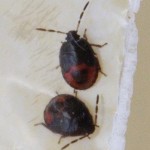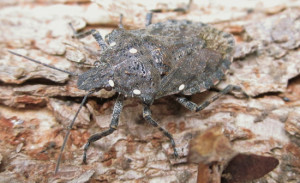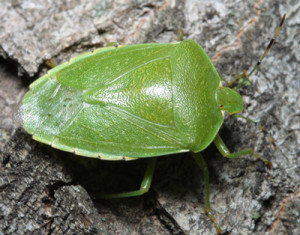The common name “stink bug” refers to a family of about 220 North American insects in the Order Hemiptera. Stink bugs are so-called because of scent glands under their bodies that emit a musty odor. They are generally oval to elliptical in shape, and of medium to large size. Like all the insects in this order, stink bugs have piercing/sucking mouthparts. But unlike many of their plant-eating cousins, not all stink bugs eat plants. Some, like the tree stink bugs in the genus Brochymena, are predators on other insects.
I was prompted to write this post because I’ve had three different folks submit pictures of what appears to be the same stink bug nymphs this week. Identification of nymphal insects is always difficult, but I submitted a couple of pictures to our museum curator, Ed Riley, and his best guess is that it looks like Cosmopepla bimaculata, the twice-stabbed stink bug. In a couple of cases, the little critters were described as very abundant.
Stink bugs that are found in large numbers on a plant are more likely to be plant feeders. Predatory stink bugs would be less likely to be crowded, and tend to disperse over many plants in search of prey. Another common stink bug is the sometime pest of vegetables and tomatoes, the green stink bug, Nezara viridula.
Rarely do stink bugs become much of a problem in urban landscapes, although vegetable gardeners may find fruits damaged by the feeding of green and brown stink bugs. If treatment is deemed necessary, most residual insecticides, such as permethrin or carbaryl, should be effective for control.


